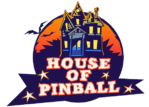If you’re shopping for a pinball machine for sale, you’ve probably come across listings that mention things like “System 11” or “System 6.” But what do these system numbers actually mean—and why should you care?
At House of Pinball, we help collectors and first-time buyers make smart, informed purchases. This guide breaks down four of the most common and historically significant pinball circuit board systems: System 3, System 6, System 7, and System 11.
Whether you’re buying, restoring, or collecting, knowing how these systems work can help you:
✅ Understand reliability and serviceability
✅ Choose the right machine for your needs
✅ Avoid costly surprises down the road
🎮 What Is a “System” in Pinball?
A “system” refers to the circuit board architecture used in pinball machines—essentially the brain and nervous system of the game. It controls everything from:
- Scoring logic
- Game rules
- Sound effects
- Lights, coils, and switches
Different systems were released over time as technology evolved. The four we’re covering today represent key generations of solid-state pinball—primarily from Bally, Williams, and Gottlieb.
⚙️ System 3 (Gottlieb)
🕹 Era: 1977–1980
🔌 Known For: Simplicity, first-generation solid-state logic
🔍 Overview:
System 3 was Gottlieb’s first attempt at moving from electromechanical to solid-state logic. These machines feature basic CPU and driver boards, with minimal memory and no sound board in earlier models.
👍 Pros:
- Historical significance
- Generally simple to troubleshoot
- Excellent starter machines for budget collectors
⚠️ Cons:
- Limited features (no multiball or advanced rulesets)
- Replacement parts can be harder to find
- May require complete board upgrades for reliability
🛒 Notable Machines Using Sys 3:
- Cleopatra
- Sinbad
- Joker Poker
🎯 Buying Tip: If you’re new to pinball and want a project machine, System 3 games are a good low-cost entry—but check for acid damage on the CPU before purchasing.
⚙️ System 6 (Williams)
🕹 Era: 1979–1980
🔌 Known For: Introducing more modern gameplay logic
🔍 Overview:
System 6 was Williams’ refinement of its early solid-state boards. It introduced more stable performance, better switch matrix logic, and sound/speech boards in some titles.
👍 Pros:
- More feature-rich than System 3
- Moderate part availability
- Easier to upgrade and repair
⚠️ Cons:
- Still uses NiCad batteries—watch for corrosion
- Some ICs are outdated or hard to source
🛒 Notable Machines Using Sys 6:
- Gorgar (first talking pinball machine!)
- Laser Ball
- Scorpion
🎯 Buying Tip: Machines like Gorgar have collector value and are beginner-friendly, but check if the boards have been re-capped or battery-modded.
⚙️ System 7 (Williams)
🕹 Era: 1980–1984
🔌 Known For: Improved audio, deeper gameplay, and better reliability
🔍 Overview:
A major leap forward. System 7 machines featured modular boards, improved memory, and enhanced soundboards. They also introduced alphanumeric displays and early multiball features.
👍 Pros:
- More immersive gameplay
- Sound effects and voice integration
- Still serviceable with modern replacements
⚠️ Cons:
- Some early boards had heat and grounding issues
- Factory boards often need recap or replacement
🛒 Notable Machines Using Sys 7:
- Black Knight
- Firepower II
- Barracora
🎯 Buying Tip: System 7 machines are popular among intermediate buyers. If the board has been upgraded or replaced, it’s a green flag for reliability.
⚙️ System 11 (Williams)
🕹 Era: 1986–1990
🔌 Known For: Iconic titles, deep rulesets, complex sound/music
🔍 Overview:
System 11 was a game-changer—pun intended. Used in some of the most iconic 80s and early 90s pinball machines, it offered integrated audio, controlled lamps, and interactive gameplay elements.
System 11 is actually split into 11A, 11B, and 11C, but all share the same core architecture.
👍 Pros:
- Excellent reliability and playability
- Tons of parts and support
- Deep gameplay and lasting appeal
⚠️ Cons:
- Higher demand = higher prices
- Check for connectors and power board issues
🛒 Notable Machines Using Sys 11:
- High Speed
- PinBot*
- Taxi
- Whirlwind
🎯 Buying Tip: A System 11 machine is a fantastic choice for both collectors and first-time buyers. Look for one with an LED upgrade and a clean power driver board.
💡 Why Circuit Board Type Affects Your Buying Decision
When you browse a pinball machine for sale, understanding its system architecture helps you:
| Factor | Impact |
|---|---|
| Gameplay depth | Newer systems (like Sys 11) offer deeper rules |
| Maintenance cost | Older systems may require more work or modern boards |
| Parts availability | Sys 6/7/11 parts are still supported; Sys 3 is limited |
| Resale value | System 11 games hold value better long-term |
| LED compatibility | Newer systems handle LED conversions better |
🛒 Buying from House of Pinball: What We Do Differently
When you shop with us, you’re not just getting a machine—you’re getting peace of mind.
✅ Every listing includes system type and technical details
✅ Expert inspections on power boards, batteries, and connectors
✅ LED upgrades and battery eliminator mods where applicable
✅ Support for new owners (video guides, phone support, parts)

